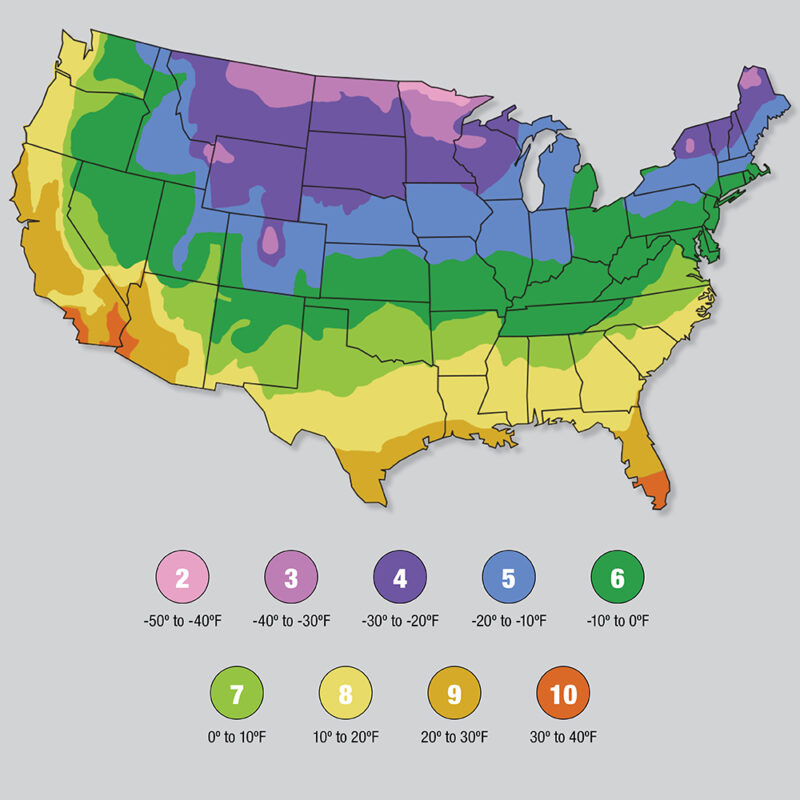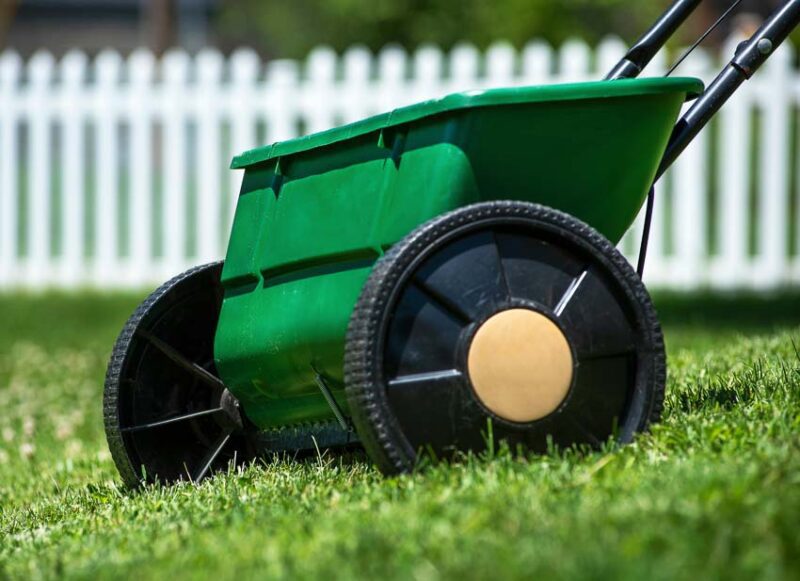As autumn gets into full swing, it’s time to start prepping your lawn for the colder weather. Proper lawn winterization is the best way to ensure your lawn will remain lush and healthy when it grows back in the spring. In this guide, we’ll go over the essential fall maintenance tasks and winter lawn care tips to protect your grass during the coldest part of the year.
Preparing Lawns for Winter in Northern Regions
For northern lawns, winter is synonymous with freezing temperatures, shorter days, and most likely some snow cover. Since many of these affect the health of your lawn, it’s important to develop a sufficient preparation strategy during the fall to prepare for your lawn’s impending winter dormancy.
Here are some tips for preparing your lawn for winter in the northern regions.
Continue Mowing into Fall
Even well into the fall season, you should maintain a regular mowing schedule. Even though its growth rate will slow down, it’s pivotal to keep mowing so that your lawn can properly drain before freezing temperatures arrive.
In autumn, gradually lower your mowing blades every mowing session as you approach the end of the season. An ideal height for your grass at the conclusion of fall is 2 to 2.5 inches. Not only does this keep your lawn looking tidy, but it also helps to avert grass fungus problems like snow mold that are prevalent during the winter.
Overseed and Fertilize in September
If you’re after a lush lawn when spring comes around, it’s a good idea to overseed and fertilize your grass in September. Cool-season grasses like fescue and bluegrass can fill in bare patches and thicken your turf before it goes dormant for the winter.
Along with the seeding process, you can also use a fertilizer that’s rich in phosphorus to help facilitate root growth establishment.
Remove Leaves Promptly

Fallen leaves can form a barrier that obstructs sunlight, so it’s important to remove leaves from your lawn promptly. If left for too long, they can cause dead patches of grass. You can remove leaves using a number of methods, including a lawn sweeper or rake, or a mulching fallen leaves with a lawn mower. If you choose the latter, it can benefit your lawn by enhancing soil nutrition without smothering your grass.
Continue Watering Lightly into Fall
As temperatures drop, your lawn doesn’t require as much water. However, it’s not advised to stop watering altogether. Maintain a regular watering schedule that provides around an inch of water per week into early November. After this, you can progressively decrease your watering pace until it stops completely. Keep in mind that once your lawn reaches dormancy, it doesn’t require any additional watering.
Treat Lingering Weeds
An active lawn can still harbor weeds like dandelions in the fall. As you prepare your lawn for winter, you should treat any lingering weeds with targeted sprays. The best time to apply broadleaf herbicides for effective results is in the early to mid-fall. You can also use pre-emergent solutions at the same time to prevent the germination of winter weeds during your lawn’s dormant phase.
Final Fall Mow
The final mow of the season should be towards the end of November, provided you haven’t received any snow yet. If you’re still able to mow at the end of November, set your blades to their lowest recommended height for your grass species. As mentioned above, this practice can help prevent fungal infections like snow mold, which can remain in longer, snow-covered grass. Once your grass has stopped growing, you can suspend your mowing schedule until spring.
Winterize Irrigation Systems
Deep freezes can threaten damage to your irrigation system and its components if precautions are not taken in time. Proper winterization includes draining supply lines, removing any residual water, and insulating exposed components like backflow preventers. Completing these steps will better safeguard your system from frozen conditions.
Fertilize 6 Weeks Before Frost
It’s also a good idea to start your last fertilization session at least six weeks before the first frost to foster a healthy transition into winter. Fertilizing helps your soil harden off properly in preparation for the winter. Once your lawn enters dormancy, it will not require fertilization until the spring growing season.
Preparing Lawns for Winter in Southern Regions

In the southern portion of the US, temperatures tend to be more mild in the winter. As such, lawn care during the fall and winter differs significantly for people in the south. Despite the mild weather, there are still preparation tasks you should complete before the winter to ensure your lawn grows back healthy and lush in the spring. Let’s dive into the essential practices to prep your southern lawn for winter.
Mow Weekly into Late Fall
Warm-season grasses, such as Bermuda and Zoysia, are scattered throughout the southern regions of the U.S. To keep these grass species healthy all year long, it’s advisable to maintain a weekly mowing schedule. You should keep mowing every week, lowering your blades until growth completely halts for the winter. This process encourages healthy growth when the warm season resumes.
Overseed Warm Season Grasses
As the year progresses into the colder months, it’s a good idea to overseed warm-season grasses with cool-season species. This can give you a lawn that maintains its green color during the winter months, rather than going brown and dormant.
Control Emerging Winter Weeds to Prepare Your Lawn
For southern lawns, winter can often bring weeds like henbit and chickweed, which thrive in cooler temperatures. When left untreated, these weeds have the tendency to overrun lawns during the latter half of the year, leading to an untidy and unkempt appearance. To control and prevent weed infestations, you can use both pre- and post-emergent herbicide products to maintain the pristine condition of your lawn.
Reduce Irrigation Gradually
Despite cooler temperatures, you will need to water your lawn into the early weeks of winter in most parts of the south. However, it’s vital to reduce your watering frequency and duration gradually to prevent diseases that thrive in cold, damp conditions. For species like Bermuda and Zoysia, allow your yard to become fully dormant before you completely stop watering. This method can save water and protect your lawn’s health at the same time.
Fertilize Until 6 Weeks Before Frost

It’s a good idea to apply slow-release fertilizers in the fall to nurture actively growing southern lawns. However, be sure to stop fertilization around mid-October for warm-season grasses. Also, never fertilize your lawn while it’s dormant. The six weeks before the first frost is a critical period when you should stop applying fertilizers to prevent lawn damage.
Mulch or Remove Fallen Leaves
While your lawn is growing, you can mow over fallen leaves to mulch them, creating small pieces that blend in with the turf. This mulching process adds nutrients to enhance your soil’s fertility. When your lawn goes dormant, you can either leave these leaves to provide insulation to the grass, or, if they become too much, you can remove them.
Clean Up Turf to Prepare Your Lawn for Winter
Preparing your lawn for winter involves more than just taking care of your grass— you also need to attend to your equipment. After your final mow at the lowest blade setting, clean and winterize your mower and store it for the season.
This is also a good time to drain and winterize your irrigation components to prevent damage due to freezing.

Winter Lawn Care Tips for Protection

Once your lawn is dormant and winter is in full effect, your lawn care routine will be fairly minimal. However, there are still tasks you can complete to protect and insulate your grass before it snows and freezing temperatures hit.
- Apply a winterizing fertilizer or potassium spray to strengthen grass plants before dormancy. Potassium boosts cold tolerance.
- During snowfall, use a broom to gently remove heavy snow from your grass to avoid damage and matting. Don’t walk on frozen or dormant grass.
- Keep piled snow away from grass areas to prevent desiccation or fungal issues from excessive meltwater.
- Let dormant lawns be and avoid high foot traffic over frozen or frosted turf.
- Cover sensitive grass like bentgrass with breathable tarps or fabric for insulation when extreme cold sets in.
- In early spring, gently rake matted grass to lift blades. Lightly apply gypsum or lime to reduce pH issues.
Ready for Lawn Dormancy this Winter?
Proper lawn preparation during the fall is crucial for keeping your lawn healthy through the cold winter months. Preparing during the fall and protecting during the winter will help your lawn thrive while dormant. Let’s go over some key maintenance activities tailored to your region’s grass.
Preparing Your Lawn for Winter FAQs
When should I stop mowing my lawn for winter?
Once your grass has stopped growing, that’s your cue to stop mowing for the winter. This usually occurs after the first hard frost, generally in late fall.
Before you stop mowing, gradually lower the blade height on your mower to help prepare your grass for winter stresses. However, don’t cut it too short, since this can expose it to diseases and winter burn. A good rule of thumb is to keep your grass 2 to 2.5 inches in height before you stop mowing for the season.
How short should I cut warm-season grasses before winter?
You can cut warm-season grasses relatively short as winter nears, around 1 to 2 inches. Cutting it short helps prevent matting underneath snow, which creates an environment favorable for certain winter fungal diseases. However, avoid scalping your lawn. Leave a little bit of length to protect the roots from the harsh winter weather.
When should I resume fertilizing my lawn in spring?
Once spring comes around, you should start your fertilization schedule back up since your grass starts actively growing. To be more specific, you can start fertilizing when your soil registers around 55°F (13°C). In many regions, this usually happens around mid to late spring. A soil test can help you determine if you need to add any nutrients to your lawn. The best bet for overall lawn health as the weather warms is to apply a balanced slow-release fertilizer that matches your soil test results.
How do I protect my irrigation system from winter damage?
To protect your system from damage due to freezing, you should completely drain it before the first hard freeze. This can be done through a manual, auto-drain, or blow-out method.
Start by disconnecting any hoses and turning off the water supply to your irrigation system. Insulate any outdoor spigots and drain any water that remains in the pipes, valves, and spray heads. It’s also recommended to insulate any valve boxes and above-ground backflow preventers to protect them from damage caused by freezing temperatures.
Can I overseed warm-season grasses like Bermuda with ryegrass?
Yes, you can overseed warm-season grasses with ryegrass— a process known as winter overseeding. This can help maintain a green lawn during the winter when Bermuda grass enters dormancy and turns brown.
Ryegrass will maintain your lawn’s green look, and it actively grows during the cooler months. However, ryegrass competes with Bermuda grass when spring rolls back around, which can potentially hinder its growth. It’s a balance between winter aesthetics and a healthy summer turf.
Related Content
Fall Lawn Care: How to Keep Your Yard Healthy This Autumn
How to Fix Brown Grass: Causes and Solutions
Best Time to Plant Grass



